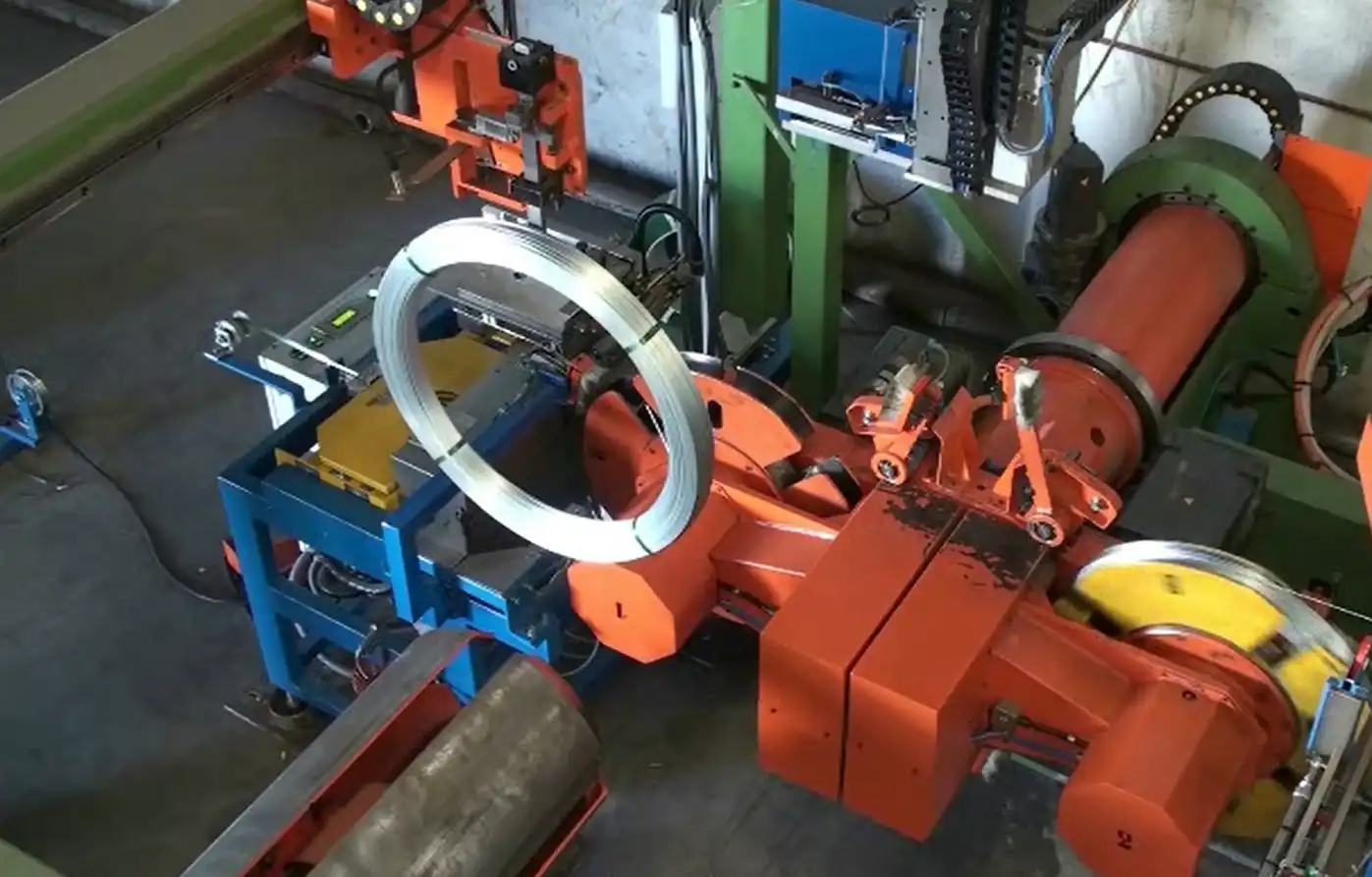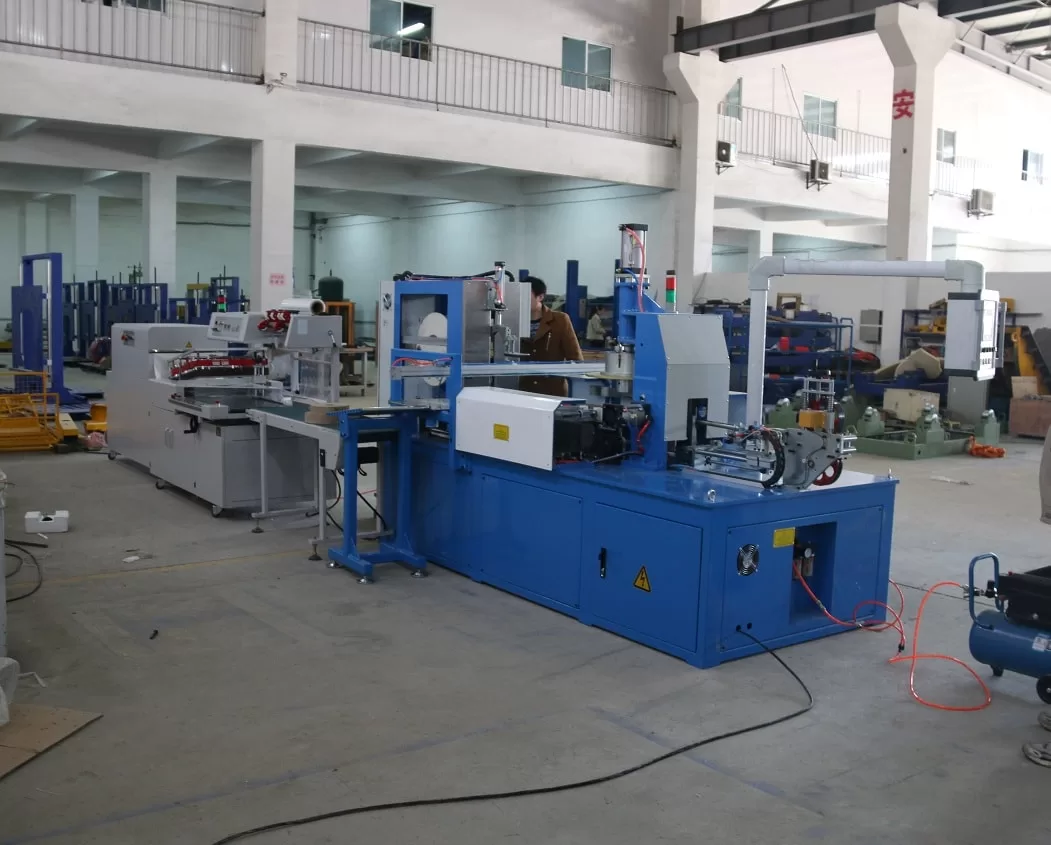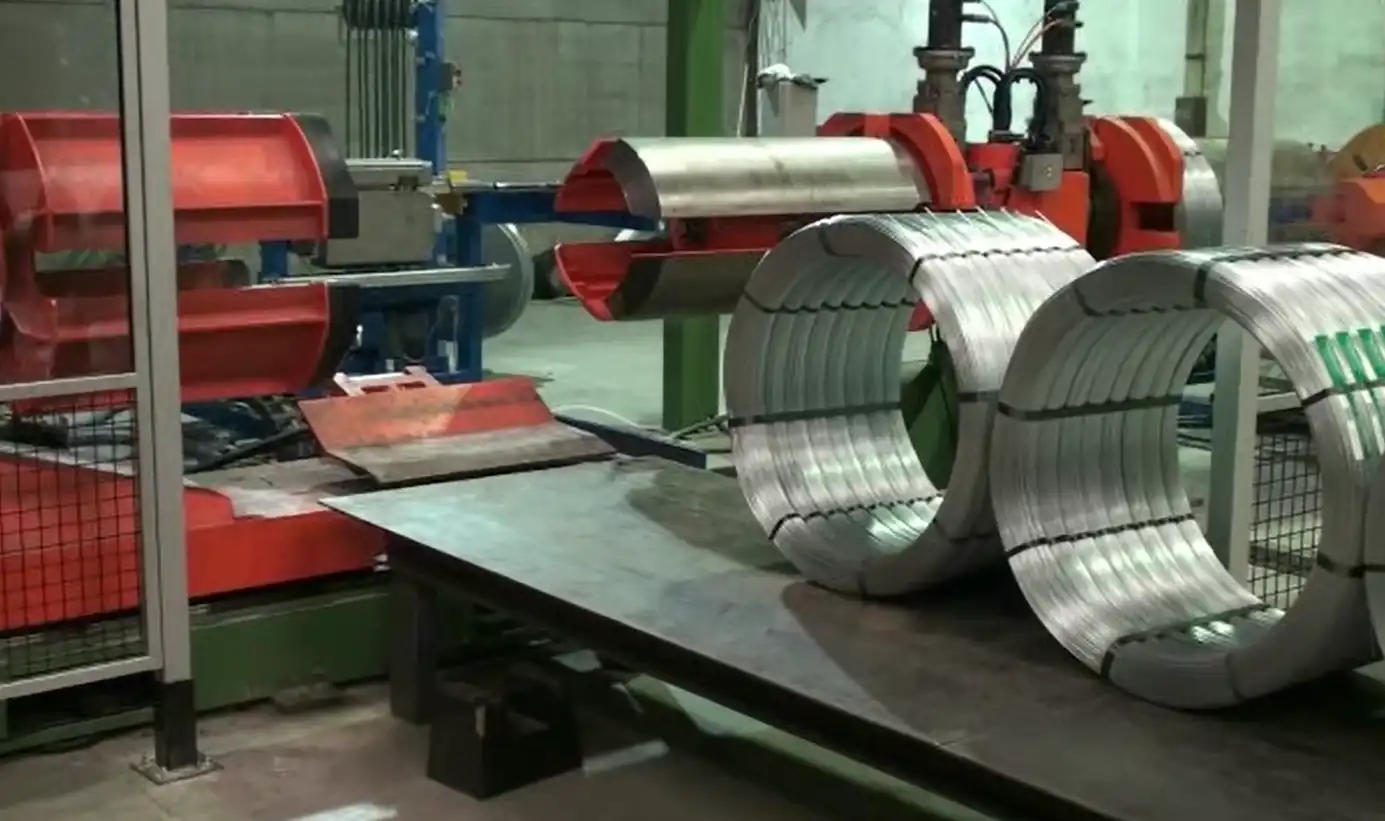Are you watching your production line struggle to keep up? Maybe you see your team manually strapping heavy steel coils or wire bundles. It's a slow, physically demanding process. Every minute they spend wrestling with strapping tools is a minute your product isn't moving out the door. You worry about the constant risk of injury, the high cost of workers' compensation, and the bottleneck it creates in your entire operation. This inefficiency directly impacts your delivery times and, ultimately, your bottom line.
Advanced steel wire strapping machines offer significant benefits by automating the packing process. They dramatically increase production efficiency, improve workplace safety by removing manual labor, protect products with consistent and precise strapping, and deliver a strong return on investment by reducing labor costs and material waste. These machines are not just an equipment upgrade; they are a strategic solution to common manufacturing challenges.

I understand that seeing these benefits on paper is one thing. But seeing how they can transform your factory floor is what really matters. As an engineer who has built a packing machine factory from the ground up, I’ve seen firsthand what works and what doesn't. Let's break down these benefits one by one, so you can see the real-world impact this technology can have on your operations, just as it has for many of my clients.
How Does an Automated Strapping Machine Boost Production Speed and Efficiency?
Does your packing station look like a race against the clock? Your team works hard, but there's a physical limit to how fast a person can wrap, tension, and cut steel straps on heavy products, hour after hour. This manual bottleneck slows down your entire production line. Delays at the end of the line can cause backups all the way to the beginning, forcing other machinery to sit idle. You know that every stalled pallet is a hit to your daily output targets.
An automated strapping machine boosts production speed by performing the entire strapping cycle—feeding, tensioning, sealing, and cutting—in a fraction of the time it takes a human. It operates continuously without fatigue, ensuring a consistent and predictable output that eliminates end-of-line bottlenecks and allows your entire facility to run at its full potential.

Eliminating Manual Bottlenecks
In a typical manual setup, an operator has to grab a heavy strapping tool, walk around the product, feed the strap, tension it, seal it, and then cut it. This can take several minutes per product, especially for large or awkwardly shaped items like steel coils. An automated machine integrates this entire sequence into a single, fluid motion. The product moves into position on a conveyor, and the machine does the rest in seconds. It doesn't get tired, it doesn't need breaks, and it doesn't slow down at the end of a long shift. This change alone can take your packing station from being the slowest part of your line to the fastest.
Ensuring Consistent Cycle Times
Humans are not robots. An operator's speed can vary based on their energy level, the complexity of the task, or even just how they are feeling that day. This makes it difficult to accurately forecast production output. Automated machines, on the other hand, provide predictable cycle times. If a machine can strap a coil in 30 seconds, it will do so every 30 seconds, all day long. This consistency is a huge advantage for a factory manager like Michael. It allows for precise production planning, reliable delivery schedules, and better management of downstream logistics. You can confidently promise a delivery date because you know exactly how many units you can pack per hour.
The Impact on Overall Throughput
When you remove the final bottleneck, the entire system can flow more freely. Think of it like a highway. If you widen the final exit ramp, you reduce the traffic jam for miles behind it. By automating your strapping process, you allow your upstream production machines to operate at their intended capacity. You are no longer limiting your factory's potential based on the physical limitations of manual labor.
| Feature | Manual Strapping | Automated Strapping |
|---|---|---|
| Cycle Time per Coil | 2-5 minutes | 20-60 seconds |
| Straps per Hour | 12-30 | 60-180 |
| Operator Involvement | Constant, intensive labor | Supervisory, occasional loading |
| Consistency | Variable, depends on operator | Highly consistent, machine-paced |
| Operational Hours | Limited by shift length/breaks | Can run 24/7 |
This shift from manual to automatic isn't just about going faster. It's about creating a more stable, predictable, and efficient manufacturing environment.
Can Steel Wire Strapping Machines Really Improve Workplace Safety and Reduce Costs?
Every time one of your workers bends down to lift a heavy strapping tool or manually handles a steel coil, do you worry about the risk? The reality of heavy manufacturing is that these tasks lead to injuries. Back strains, cuts from sharp strap edges, and repetitive motion injuries are common. These aren't just unfortunate incidents; they are serious business problems. They lead to lost workdays, high insurance premiums, potential legal issues, and a constant cycle of hiring and training new staff to replace injured workers.
Yes, steel wire strapping machines directly improve workplace safety by automating the most physically demanding and hazardous tasks. This automation dramatically reduces the risk of common industrial injuries. The result is a significant reduction in direct and indirect costs, including lower insurance premiums, fewer workers' compensation claims, and improved employee retention.

From High-Risk to Low-Risk Operations
Manual strapping is a high-risk job. An operator is constantly interacting with heavy machinery, heavy products, and tools that can cause harm. An automated strapping machine changes this dynamic completely. The machine handles the dangerous work. The operator's role shifts from performing the physical labor to supervising the machine. They are no longer in the "danger zone." They stand back, monitor the process, and only interact with the machine for simple tasks like replenishing the strap coil. This single change can fundamentally alter the risk profile of your packing area, making it one of the safest parts of your plant instead of one of the most dangerous.
The Hidden Costs of Manual Labor
The cost of an employee isn't just their salary. When you factor in the "hidden" costs associated with manual labor in a high-risk environment, the numbers add up quickly. I have seen clients who were shocked when they calculated the true cost of an injury. It includes medical bills, lost productivity, the cost of hiring and training a replacement, and a potential spike in your insurance rates for the whole company. High employee turnover is another major cost. When a job is physically punishing and dangerous, people leave. Finding, hiring, and training their replacements is a constant drain on time and resources.
| Cost Factor | Manual Labor | Automated Machine |
|---|---|---|
| Labor Cost | High (Wages + Benefits for 1-2 operators) | Low (Supervisory role, not full-time) |
| Insurance Premiums | High (due to injury risk) | Lower (reduced risk profile) |
| Injury-Related Costs | High (Medical, compensation, lost time) | Minimal to None |
| Turnover & Training | High (due to physically demanding job) | Low (easier job, higher retention) |
| Initial Investment | Low (hand tools) | High (machine cost) |
| Long-Term ROI | Poor | Excellent |
Investing in an automated machine might seem like a large upfront expense. But when you compare it to the ongoing, unpredictable, and high costs of manual labor, the financial case becomes very clear. It’s an investment in stability, safety, and long-term profitability.
In What Ways Do Modern Strapping Machines Protect Your Products and Reduce Damage?
Have you ever had a customer call to complain about a shipment? They send a photo of a steel coil with a dented edge or a bundle of wire that has come loose and tangled during transit. It's frustrating. You spent time and money to produce a quality product, only for it to be damaged in the last stage of the process. This damage leads to rejected shipments, costly returns, and, worst of all, a loss of customer trust. The problem often comes down to one simple thing: inconsistent strapping.
Modern strapping machines protect your products by applying the perfect amount of tension every single time. They place straps precisely where they are needed to secure the load and prevent shifting. This consistent, controlled process protects vulnerable edges and ensures the product arrives at its destination in the same condition it left your factory, reducing damage-related losses and customer complaints.

The Science of Consistent Tension
When an operator tensions a strap by hand, the force is subjective. It can be too tight, which can crush or dent the product, especially on the edges of a steel coil. Or, it can be too loose, which allows the product to shift and get damaged during shipping. A modern strapping machine removes this guesswork. You can program the exact tension required for a specific product. The machine's sensors ensure that this exact force is applied to every strap on every product. It's not a matter of feel or strength; it's a matter of precise engineering. This scientific approach to tensioning is the key to preventing a wide range of product damage.
Protecting Vulnerable Points
Many products have specific weak points. For a steel coil, it's the outer and inner edges. For a bundle of steel bars, it's the ends. A machine can be programmed to place straps in the exact locations that provide the most support. This might mean placing multiple straps close together near the edges or using protective corner pieces that are automatically applied before strapping. A manual operator might rush and place straps in suboptimal positions, but a machine follows its programming perfectly. This targeted protection is something that is very difficult to achieve consistently with manual labor.
Reducing Load Shifting During Transit
The journey from your factory to your customer is often rough. Trucks bounce, ships sway, and trains rattle. If a load is not perfectly secured, it will move. When a multi-ton steel coil shifts on a pallet, it can easily damage itself and other products around it. A properly strapped load is a stable load. The consistent tension and precise placement from an automated machine create a solid, unified block that resists the forces of transportation. This is your best insurance policy against transit damage.
| Damage Factor | Manual Strapping | Automated Strapping |
|---|---|---|
| Tension Control | Inconsistent, often too high or too low | Precise, programmable, and consistent |
| Strap Placement | Variable, prone to operator error | Exact, programmed placement |
| Edge Protection | Often forgotten or applied poorly | Can be integrated into the process |
| Load Stability | Unreliable | High and predictable |
| Result | Higher risk of product damage/complaints | Lower risk, improved customer satisfaction |
Investing in better strapping is a direct investment in your product's quality and your company's reputation.
What Should You Consider When Integrating a Strapping Machine into Your Existing Production Line?
So, you're convinced that a strapping machine is the right move. But the thought of installing a large piece of equipment into your finely tuned production line can be daunting. Where will it fit? Will it communicate with your existing conveyors and control systems? Choosing the wrong machine or failing to plan the integration can create more problems than it solves, leading to unexpected downtime and frustration. It's a legitimate concern for any hands-on factory manager.
When integrating a strapping machine, you must consider its physical footprint, its compatibility with your material handling systems like conveyors, the necessary level of automation for your needs, and the supplier's capability to provide technical support for a seamless installation and startup. A successful integration depends on careful planning before the purchase.
Assessing Your Physical Space and Layout
The first step is practical. You need to measure your available space. Look at your current packing area and determine where the machine could physically go. You have to think about more than just the machine's dimensions. You also need space for operators to access it for maintenance, for loading new coils of strap, and for the flow of products in and out. I always advise clients to create a simple floor plan. It helps visualize how the machine will fit and how it will change the workflow in that area. Will it improve the flow or create a new obstacle? Answering this question early is critical.
Ensuring System Compatibility
A modern factory is a connected system. Your new strapping machine cannot be an island. It needs to "talk" to the equipment before and after it. This involves a few key things. First, conveyor compatibility. The height and speed of your existing conveyor line must match the machine's specifications. Second, control system integration. If you want a fully automated process, the strapping machine's PLC (Programmable Logic Controller) needs to communicate with your factory's main control system. This "handshake" tells the machine when a product has arrived and tells the line when the product is ready to move on. Working with a supplier who understands these electrical and software integrations is essential to avoid major headaches.
Choosing the Right Level of Automation
Not everyone needs a fully robotic, top-of-the-line system. The right choice depends on your volume, product type, and budget.
- Semi-Automatic: The operator places the product and manually feeds the strap around it, but the machine does the tensioning, sealing, and cutting. This is a good step up from fully manual and is great for lower volume operations.
- Automatic: The machine is placed within a conveyor line. It automatically detects the product, straps it according to pre-set patterns, and sends it on its way. Operator involvement is minimal. This is ideal for most medium to high-volume factories like Michael's.
- Fully-Automatic: This includes features like automatic coil changing, automatic fault detection, and integration with a central factory management system. This is for high-volume, 24/7 operations where minimizing any potential downtime is the absolute top priority.
| Integration Checklist | Key Question |
|---|---|
| Space & Layout | Have we measured the space and planned the workflow? |
| Conveyor System | Is the machine's height and speed compatible with our line? |
| Control System | Can the machine's PLC communicate with our factory controls? |
| Power & Utilities | Do we have the required electrical and compressed air supply? |
| Product Type | Is the machine designed for our product's size, shape, and weight? |
| Supplier Support | Does the supplier offer installation, training, and service? |
Thinking through these points turns a potentially complex project into a manageable one. It ensures you buy the right machine and that it works for you from day one.
My Insight
I remember talking to a factory manager in Mexico a few years ago. Let's call him Michael. He was experienced, sharp, and responsible for a large metal processing plant. When I visited his factory, I could see the problem immediately. He had a state-of-the-art production line making beautiful steel coils, but at the very end of the line, two workers were struggling to strap these heavy coils onto pallets by hand. They were tired, the area was cluttered with tools, and the entire multi-million dollar production line was forced to wait for them to finish.
Michael told me his challenges, and they were the same ones I hear so often. He was worried about safety. He had a close call a few months prior where a worker nearly crushed his hand. His insurance costs were climbing. He was frustrated by the inefficiency. He knew he could produce 20% more product if he could just get it out the door faster. And he was skeptical of suppliers. He told me, "Vincent, I’ve bought machines before from people who promise the world. They take my money, and then I can never get them on the phone again when something goes wrong." He wasn't looking for a machine. He was looking for a partner who understood his problem.
We didn't just talk about machine specs. We walked his floor. We timed his manual process. We talked to his operators. We mapped out how a new machine would fit, how it would connect to his existing conveyor, and what kind of training his team would need. I shared stories from my own time running a factory, the mistakes I made, and what I learned. I explained that the goal wasn't to sell him a box, but to provide a total solution—that's our slogan, and I take it seriously.
We installed an automatic coil strapping line for him. Six months later, he called me. He said, "Vincent, I should have done this five years ago." He told me his packing output had doubled. He hadn't had a single safety incident in the packing area since the installation. And the best part for him? He was finally able to meet the increased demand from a major new customer, which helped his business grow significantly. That's what this is all about for me. My journey in this industry has given me so much. Now, my mission is to share that knowledge and help other people like Michael solve their problems and build successful businesses.
Conclusion
Ultimately, adopting advanced strapping machines is a strategic investment in your factory's future. It boosts efficiency, enhances safety, and protects your products, paving the way for sustainable growth and profitability.




